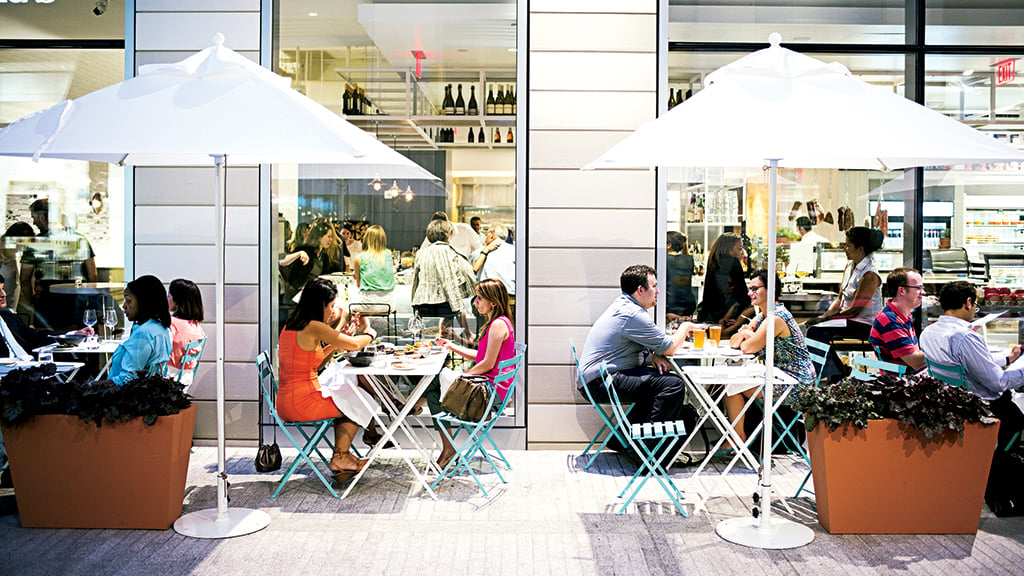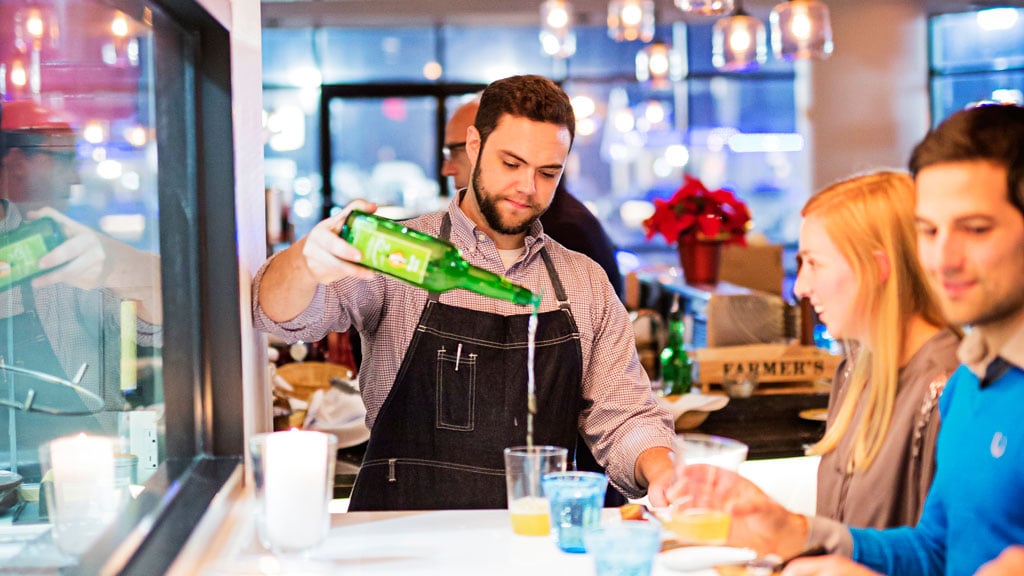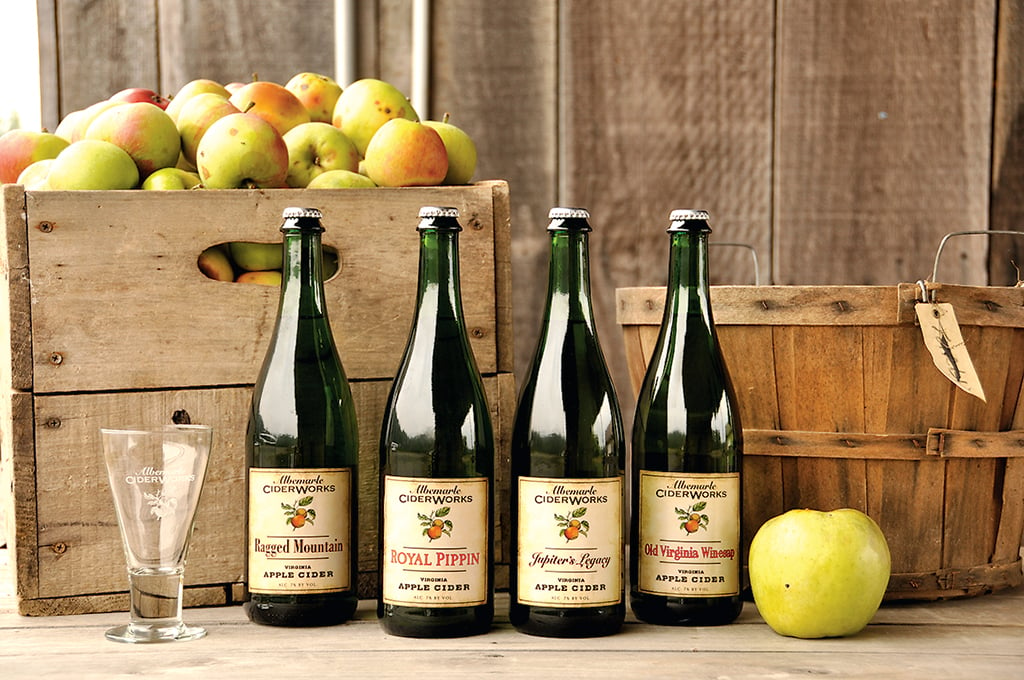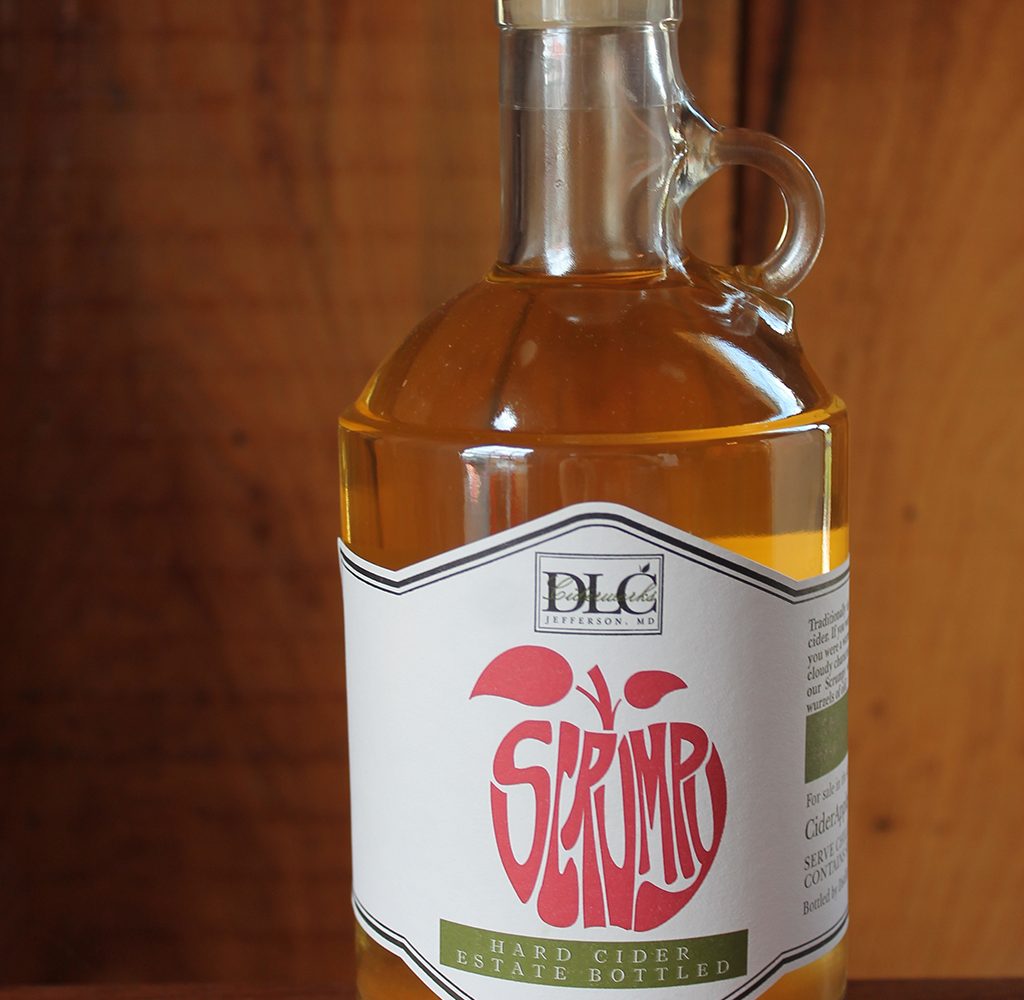I’ll Have The Lobster
BECAUSE IT IS PRICEY, many people think of lobster as a costly indulgence in the same class as foie gras, truffles, and caviar. What else should one conclude when a small submarine roll stuffed with lobster salad fetches $23 at Kinkead's; when a three-pound lobster is a $66 main course at the Palm; and when the pleasure of nibbling on a couple of slices of sauced lobster at Michel Richard Citronelle will set you back $45?
But if you stay away from the tables of great chefs and avoid luxury-class steakhouses, there are some affordable lobsters to be enjoyed locally. Noodle dishes and vegetable preparations subsidize the high cost of lobster in Chinese restaurants, so count on Chinatown to provide the area's best buys. A lobster stir-fried with ginger and scallions at Eat First, along with a stir-fried vegetable and a noodle dish, will cost a couple little more than $50, including tax, tip, and tea.
And there are other fairly priced lobster dishes in the area. Smith & Wollensky, the top-shelf steakhouse from Manhattan, serves a sweetly fresh, wonderfully tender, one-pound chilled steamed lobster, its tail split and claws cracked, for $13.50. You'll find it on the menu as a "Lobster Cocktail."
With two days' notice, chef Patrick Orange of La Chaumière will prepare his version of Homard à l'Américaine–a classic French dish–with a two-pound lobster for $35. When you consider that steakhouses are charging $22 a pound for unsauced steamed lobsters, Orange's interpretation of this classic is an excellent value.
Here is a survey of the most interesting lobster dishes you'll find in the area.
A LOT OF DINERS EXPECT LOBSTER and Champagne to be an ideal combination. With a hot steamed lobster, whose natural richness is magnified when morsels of it are dipped in melted butter, only the fullest-bodied Champagnes will prove a successful match. Traditionally light Champagnes, such as Moët et Chandon's Brut Non-Vintage or the even more sprightly Taittinger "La Francaise" Brut Non-Vintage, are good apéritifs but lack the fullness and firmness to partner ably with steamed lobster. If you want to drink Champagne with a steamed lobster, choose among the heavier bubblies, such as the brut nonvintage bottlings from Bollinger, Laurent-Perrier, Veuve Clicquot, and Krug.
Variously sauced preparations of lobster–whether a classic Homard à l'Américaine or a contemporary creation such as Gerard Pangaud's Lobster With Ginger and Lime-Sauternes Sauce–are usually not successfully matched with Champagne because their sauces tend to emphasize the acidity of the wine or imbue it with off flavors. A search through two classic French books on the partnership between food and wine–Raymond Brunet's Le Mariage des Vins and des Mets, published in the 1930s, and Le Gout Juste des Vins et des Plats, written by Jacques Puisais in the mid-1980s–yields not a single mention of Champagne as a companion for lobster.
Depending on the preparation of the lobster, the wines mentioned frequently by Brunet and Puisais are the white Burgundies from the vineyards of Puligny-Montrachet, Chassagne Montrachet, and Meursault and the Hermitage Blanc from the northern Rhône. At their best, all are among the fullest-bodied, most richly flavored white wines in France.
During this survey, the most successful pairings with California wines involved big Chardonnays, such as those from Sonoma-Cutrer, and a couple of Viogniers, rich and exotic whites made from a grape native to the northern Rhône, where it produces a heady white called Condrieu. Although all three wines were vinted from the same varietal, the two California Viogniers paired much more successfully than the lone Condrieu, which lacked the power to complement a four-pound steamed lobster at the Palm.
Hand-Held Lobster: Fabulous Sandwiches At Fabulous Prices
Kinkead's (2000 Pennsylvania Ave., NW; 202-296-7700). Lobster Roll, $23.
Tradition provides both inspiration and a point of departure for chef Bob Kinkead's interpretation of American classics. Maine's traditional lobster roll–which, at its most pedestrian, can be a toasted hot-dog bun stuffed with pieces of frozen lobster meat bound in institutional mayonnaise–is elevated to a delicacy at Kinkead's: The custom-baked bun looks like a mini sub roll with a lightly crunchy crust, and the chunks of lobster, sparingly bound with house-made mayonnaise, are wonderfully sweet. The filling tastes as though it were assembled to order rather than scooped out of a refrigerated bin. The white spaces on the plate were covered by thin French fries that were limp and cole slaw that was far too assertive in flavor.
A French Champagne, Louis Roederer Brut N.V., was a pleasant match.
Legal Sea Foods (2020 K St., NW; 202-496-1111). Lobster Roll, $17.
Served in a butter-grilled "top-loader" bun, Legal Sea Foods' sandwich is made with the meat of a 11/4-pound lobster lightly held together with mayonnaise. It was pleasant, but the meat was not as sweet as that at Kinkead's. It was nicely garnished with impeccable French fries and a very fresh-tasting, not-too-sweet cole slaw.
A Sonoma-Cutrer "Russian River Ranch" Chardonnay 2001, with its lush, mouth-filling fruit properly balanced with just the right amount of acid in its aftertaste, matched the richness of the sandwich's filling.
Michel Richard Citronelle (Latham Hotel, 3000 M St., NW; 202-625-2150). Lobster Burger, $20.
Michel Richard sees similarities in a pair of different ingredients that less imaginative chefs would overlook. The similarity in color of a thick slice of raw tuna and that of the beef chuck that makes a very good hamburger inspired the chef to create a "tuna burger" for Californians who had given up red meat but still had a craving for it. The result, a patty seared on the outside and all but raw on the inside, was sushi in a bun. It was copied and recopied by so many chefs that today a tuna burger on a menu is no more of a surprise than a veggie burger.
Richard still offers his tuna burger at Citronelle's bar, but nowadays it is outsold by his lobster burger. Served on a buttery bun baked from brioche dough–whose only drawback is that it tends to disintegrate during the eating of the burger–it is a thick patty formed from large chunks of lobster topped with a crisp Parmesan wafer and resting on a lively tomato purée. Each bite detonates an explosion of rich lobster flavor.
If it is available on Citronelle's frequently changing selection of wines by the glass, Chapoutier's "Chante Allouette" Hermitage Blanc 1997 is a fine partner for the lobster burger.
For Starters–Or For A Luxurious Light Lunch
Cafe 15 (Sofitel Lafayette Square Hotel, 806 15th St., NW; 202-730-8800). Lobster Salad, $19.
Chef Antoine Westermann may be one of the more conservative practitioners of contemporary cooking to have earned a three-star rating from the Guide Michelin, but he is not immune to nouvelle cuisine's penchant for fanciful menu descriptions that lead diners to expect something different from the dish that arrives. A first course entitled Lobster Salad, Vegetable Minestrone, Tomato Purée, Basil Oil is a case in point.
The dish is so dainty in portion that it takes about as long to read its description as it does to eat it. The lobster's tail–sliced into medallions and presented in overlapping slices over a coarsely textured tomato sauce–is so small that it could be mistaken for a shrimp. Then there is the matter of the "Vegetable Minestrone." Instead of a minestrone there is a confettilike scattering of zucchini, celery, and carrots that far more resembles the dice of aromatic vegetables called a mirepoix than it does the soup.
Whimsy aside, it is a delicious nibble, its four- or five-bite portion making it more an hors d'oeuvre than a first course. The tail and a single claw are served lukewarm and shelled, their delicate sweetness contrasted with a tuft of lightly dressed baby salad greens. It may not be what most would expect when ordering a lobster salad, but, correct in all of its elements, it is a delicacy.
With its scent a mixture of melon and honey, and its rich, palate-coating fruit, the Zacamesa Viognier 2000 is a good match for a first course of lobster at Cafe 15.
Smith & Wollensky (1112 19th St., NW; 202-466-1100). Lobster Cocktail, $14.50.
What the menu lists as a "cocktail" is not the expected dish of chilled chunks of lobster. It is a cold, one-pound steamed lobster, its tail split and claws cracked.
It is served with a piquant ginger sauce and a traditional tomato-horseradish cocktail sauce that is best ignored. It also can be ordered with a classic tartar sauce and a dense mayonnaise. While the light spiciness of the ginger sauce points up the lobster's sweetness, the mayonnaise provides its ideal complement. The dish is grand as a preface to any of Smith & Wollensky's top-prime steaks or as a light lunch by itself.
Taittinger "La Francaise" Brut Non-Vintage–here served at $15.50 a glass–was the most pleasant of all the wine-and-lobster pairings in this survey. Although it is one of the lightest of all nonvintage Champagnes, it was an incisive complement to this marvelous little lobster.
All-American Lobsters: Natural And Not
Legal Sea Foods (2020 K St., NW; 202-496-1111). Baked Stuffed Lobster (2 to 2H pounds), $48.
A carelessly prepared topping of breadcrumbs, mixed seafood, and red bell peppers keeps the tail meat of Legal Sea Foods' baked stuffed lobster from drying out in a hot oven, but is hardly a complement to the lobster. It is a mixture of excessively buttered bread crumbs, coarsely diced red bell peppers, irregularly cut pieces of scallop, and an occasional half of a small shrimp.
A finer dice of red bell pepper, scallops cut into a small dice, and a good deal less butter in the crumb mixture would make the stuffing less clumsy. Legal Sea Foods invests so much in securing the best seafood and maintaining its quality with state-of-the-art shipping methods, it is a shame that one careless cook can spoil what could be a very fine baked lobster.
A Jordan Chardonnay 2001 was too slight to complement the lobster's richness. A half bottle of Miner "Simpson's Vineyard" Viognier 2001 has a melony, honeyed richness that provides a fine match.
The Palm (1225 19th St., NW; 202-293-9091). Steamed Four-Pound Lobster, $88.
At $22 a pound, the Palm's lobster cost $10 less per pound than its superb two-pound Steak for Two at $64. But don't expect to order a two-pound lobster at the Palm: This is Washington's power restaurant, and the runts in its lobster tank weigh in at a 3 to 3H pounds. and you're more likely to spot 4, 5, or 6 pounders in cramped repose on mammoth platters.
The four-pounder shared as a main course was a magnificent sight and perfectly steamed–once again giving lie to the myth that lobsters over two pounds are tough. No matter their size, lobsters are tough only when they are cooked too long or at an excessively high heat. This lobster has splendidly sweet meat that slips out of the tail halves at the slightest tug of the fork and is easy to draw out whole from precracked claws. The ramekin of melted butter benefits from the addition at table of the juice from the lemon wedges that garnish the platter, which leavens its fatty richness and lends a refreshing contrast of acidity to the natural sweetness of the lobster.
A Condrieu 1999 produced by Detoncins is an oddity on the Palm's largely American list, but as a small-production white made in the northern Rhône from the Viognier grape, it was an intriguing alternative to one of the heftier California Chardonnays. Showing the melonlike aroma and honeyed quality typical of the varietal, it was a barely adequate match for the fine lobster. One of the full-throttle California bottlings of the grape, such as the superb Joseph Phelps "Le Mistral" Viognier, would have complemented the dish better.
Lobster With Garlic, Tomato, And Hot Peppers: Viva Italia
Cafe Milano (3251 Prospect St., NW; 202-333-6183). Linguine With Lobster, $29.
Franco Nuschese, the owner of Cafe Milano, claims the linguine with whole lobster is his most frequently ordered pasta. Al dente linguine is topped with a 11/4-pound lobster sautéed in a bare slick of olive oil with a suspicion of garlic, a few specks of tomato pulp, and a pinch of dried hot-pepper flakes, which intensify the lobster's sweetness. The restrained portion of pasta glistens with a spare glaze of lobster-flavored oil. It is an elegant version of what often is a rough-hewn dish, such as the Italian-American classic Lobster Fra Diavolo.
Since many Italians drink red wine with seafood as well as with meat and poultry, the linguine with lobster was paired with a Valpolicella Speri 2000, a soft, fruity wine with low tannin. A lighter wine, such as Valpolicella Le Poiane 1998, also would make a good red-wine match. Nuschese's personal choice is the 2000 Jermann "Vintage Tonina," a full-bodied white whose wealth of fruit complements the lobster's sweetness. At $99, it is a heady choice.
Chinatown Offerings: Not Yesteryear's Bargains, But Still A Good Value
Chinatown Express (746 Sixth St., NW; 202-638-0424). Sautéed Lobster, $16.95.
At this quirky dining room–best known for its fresh, hand-pulled noodles called lai mein and its Shanghai Soup Dumplings–you'll find Chinatown's bargain lobster, a 11/4-pound beauty stir-fried with ginger and scallions. The preparation is as good as it gets along H Street's stir-fry corridor. The price fluctuates seasonally between $13.95 and $16.95. If you partake of this bargain, be forewarned: The sassy daytime hostess has been known to check on how thoroughly a diner has picked the flesh from the lobster's shell. If she spies a morsel or two clinging to the shell, she will chide you for not doing a good enough job. It is a scolding done in good humor.
Eat First (609 H St., NW; 202-289-1703). Lobster Stir-Fried With Ginger and Scallions, $24.95.
In restaurants that specialize in the cuisines of Canton and Hong Kong, the lobster preparations most often encountered are Lobster Cantonese, with its soothing, egg-drop sauce textured with ground pork; Lobster With Black-Bean Sauce, whose salty, smoky gravy can overwhelm the lobster; and Lobster Stir-Fried With Ginger and Scallions, sometimes called "Smoked Lobster" because cooking it in a superheated wok with a bare minimum of oil imparts a smoky flavor. Among the Chinese clientele, this last is the favored treatment for lobster..
Eat First's lobster is a beauty, cleaved into manageable pieces that expose a maximum of flesh to the smoking oil in the wok. The spiciness of crushed slices of ginger and the sweetness of the stir-fried scallions conjoin to point up the natural flavor of the superb lobster, making this one of the best treatments in this survey.
Tony Cheng's Seafood Restaurant (619 H St., NW; 202-371-8669). Spicy Lobster Szechuan-Style, $28.95.
The Chinese patrons who crowd this second-story dining room for the bounty of lobsters and Dungeness crabs in its tanks are most likely to order either crustacean stir-fried with ginger and scallions. But for the sake of variety, the lobster netted from Tony Cheng's tanks was ordered Szechuan-style. It was presented in a shallow pool of dangerous-looking red sauce, which turned out to be an only mildly spicy Chinese-style tomato sauce with ginger and sweetened with onions and scallions. But the sauce masks the lobster's own natural sweetness. A less restrained use of chilies, which would have produced that hot-sweet flavor so complementary to shellfish of all kinds, would have been a better complement for the lobster. To their credit, both the manager and the waiter suggested that this fine lobster be stir-fried with ginger and scallions, rather than prepared in the Szechuan style. They were right.
High-Style Crustaceans With French Flavors
Cafe 15 (Sofitel Lafayette Square Hotel, 806 15th St., NW; 202-730-8800). Roasted Maine Lobster, Apple-Potato Purée, Red Wine Jus, $32.
Listed as a main course, the Roasted Lobster at Cafe 15 is an object lesson in why some Washingtonians have come to disdain nouvelle cuisine: Relative to its price, its small portion seems outrageous. The tiny lobster is smaller than some of the jumbo prawns served at Vietnamese restaurants. In the context of a five- or six-course fixed-price tasting menu, it would be acceptable; as an à la carte main course, it is too meager.
That said, what there is of it is very good. A reduction of Merlot with meat glaze (made with veal) gives the lobster a "meaty" flavor. Its accompanying spoonful of potato purée textured with a tiny dice of lightly cooked apple provides a fine complement.
The red-wine reduction managed to undo most of the wines paired with the lobster. The Chandon Blanc de Noirs was reduced to a fizzy wine. The Zacamesa Viognier 2000, a comfortable pairing with Cafe 15's lobster salad, was a shrinking violet with the main course. A soft Canyon Road Merlot 2000 was not an ideal match but was better than the other wines.
Gerard's Place (915 15th St., NW; 202-737-4445). Poached Maine Lobster With Ginger, Lime-Sauternes Sauce, Diced Red Pepper, Avocado, and Mango, $52.50.
Chef Gerard Pangaud's signature lobster dish is a 21-year-old piece of history. It began as a lobster salad with ginger and a lime-Sauternes dressing on a menu the chef had been commissioned to create by the winemakers of Sauternes. In 1982 it evolved into a hot course on the menu of a dinner Pangaud cooked at Versailles for delegates to a G-7 economic summit meeting.
The dish continues to keep gastronomic tourists and local regulars returning to Gerard's Place. Like most of Pangaud's cuisine, it is an elegant understatement that requires savoring before it reveals the interplay among its flavors. What makes it such an enduring success is the balance it achieves in using all four of the flavors that our taste buds perceive: saltiness (the lobster), acidity (the lime juice), bitterness (the fresh ginger), and sweetness (the Sauternes, red pepper, mango, and lobster). The avocado reinforces the buttery texture of the sauce. The counterpoint among the four flavors is the equivalent of chamber music for the palate.
The light sweetness of the lime-Sauternes sauce, which brings out the acid edge in wines, precludes matching the dish with fruity, dry white wines such as California Chardonnays or an Hermitage from the Rhône. A natural complement for Pangaud's lobster is Chateau Gaudiet 1999 from Loupiac, a light-bodied, naturally sweet wine with enough acid to balance its sugar and fruit. A late-harvest Vouvray Moelleux "La Peau de la Moriette" Domaine Pichot 1990, slightly more delicate in its sweetness than the Chateau Gaudiet, made for a similarly attractive match.
La Chaumière (2813 M St., NW; 202-338-1784). Homard à l'Américaine, $35.
No local French restaurant regularly offers Homard à 1'Américaine, one of the two lobster dishes the great French food writer Robert Courtine lists in his book The Hundred Glories of French Cooking. But a refined version of the dish–strict classicists would say too refined–is yours for the asking, with two days' advance notice, at La Chaumière.
Courtine traces the origins of the dish to the 19th century, when it was created in a Paris restaurant called Peter's by a chef named Pierre Fraisse, who cooked it up for a group of American diners. In its classic form, the lobster is sautéed in olive oil with onions, garlic, tomato, cayenne pepper, white wine, and tarragon. After the lobster is cooked, the sauce in the pan is thickened with the lobster's liver, roe, and butter. The flavors of the dish are definitely from Provence, which makes sense: Fraisse was a native of the south of France.
The request for the dish here was placed with Patrick Orange, a chef who worked for years at La Colline with Robert Greault, the last of Washington's classic French chefs. The result was a precisely sautéed two-pound lobster, glazed with a medium-bodied sauce made by straining the liquids and solids in the lobster's cooking pan. If you want to taste the original version, a robust stew of lobster textured with chopped onions and diced tomatoes, ask that it be prepared that way when you order. The portion is sufficient to share as a first course.
An elegant Chateauneuf-du-Pape Blanc "Ancien Domaine des Pontiefs" 2001 was a very good value at $42, sufficiently rich to partner both the lobster and its fine sauce.
Michel Richard Citronelle (Latham Hotel, 3000 M St., NW; 202-625-2150). Lobster Medallions With Citronelle Sauce, $45.
Beyond the simple beauty of its presentation–pearly slices of crimson-rimmed lobster centered on a wash of brick-red sauce–the most striking thing about Michel Richard's Lobster Medallions With Citronelle Sauce is the tenderness of the lobster. Like all great cooking, it is the result of impeccable ingredients' being cooked with flawless technique. The secret of producing lobster slices as tender as sea scallops is to cook the crustacean in a 275-degree oven for about 25 minutes, which gently firms the flesh without turning it rubbery.
Richard's admirable restraint in the use of lemongrass in the sauce prevents it from taking on the character of East-West fusion cooking. The sauce looks and almost tastes like a classic sauce Américaine, yet has a barely discernible nuance of lemongrass. The sweetness of the lobster is echoed by garnishes of sliced artichoke bottoms and Jerusalem artichokes, which fill a fried nest of finely shredded potatoes. The Lobster Medallions With Citronelle Sauce is available à la carte for $45 in the restaurant's upstairs bar and at the tables of its cocktail lounge, and the dish is among the main-course choices offered as part of several fixed-price menus, which begin at $75 for three courses.
Once again, a white from the Rhône demonstrated its affinity for sauced lobster preparations served hot. This time it was M. Chapoutier's "Chante-Alouette" Hermitage Blanc 1997, which complemented the lobster and its sauce without showing any off flavors. It was a perfect partner for a remarkable dish.

















